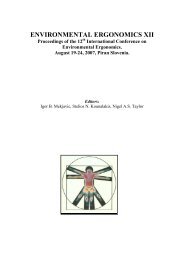Development of self-compacting concrete
Development of self-compacting concrete
Development of self-compacting concrete
You also want an ePaper? Increase the reach of your titles
YUMPU automatically turns print PDFs into web optimized ePapers that Google loves.
A specification and guideline document has recently been<br />
produced by EFNARC (European Federation <strong>of</strong> Producers and<br />
Contractors <strong>of</strong> Specialist Products for Structures) which aims to<br />
provide a framework for the design and use <strong>of</strong> high-quality<br />
SCC in Europe based on the latest research findings combined<br />
with field experience. 22 It is probably the first European<br />
guidance document to be universally available, and is freely<br />
available on the internet. 23 It is intended that the document be<br />
updated as SCC technology evolves and advances.<br />
Most <strong>of</strong> the major European countries are currently in the<br />
process <strong>of</strong> developing guidelines or specifications for the use <strong>of</strong><br />
SCC. Table 1 shows a snapshot <strong>of</strong> the current stage in the<br />
development <strong>of</strong> SCC guidelines or specifications for each <strong>of</strong> the<br />
European countries listed.<br />
4.1. Scandinavia<br />
As described earlier, Sweden was at the forefront <strong>of</strong> the<br />
development <strong>of</strong> SCC outside Japan and it is estimated that SCC<br />
now accounts for approximately 7–10% <strong>of</strong> the Swedish readymix<br />
market, 25 up from approximately 3% in 2000. Currently,<br />
the CBI, four universities and the government in Sweden are all<br />
conducting research into SCC.<br />
SCC is <strong>of</strong>ten used in Sweden today by contractors such as NCC<br />
on a commercial basis. 26 NCC and other Swedish contractors<br />
are also conducting research into SCC, both internally and with<br />
other companies and universities/institutes. The Swedish<br />
Concrete Association (SCA) has also recently published<br />
recommendations for the use <strong>of</strong> SCC. 27<br />
The volume <strong>of</strong> SCC produced in Norway has increased from<br />
approximately 0·5% (or 12 000 m 3 ) <strong>of</strong> total <strong>concrete</strong> volume in<br />
2000 to approximately 1·2% (or 29 500 m 3 ) in 2001. 28 A<br />
Norwegian guideline for the production and use <strong>of</strong> the material<br />
was issued in late 2001 and an English translation has recently<br />
been completed.<br />
SCC is used in Finland only to a limited degree, although<br />
companies such as Lohja Rudus and Parma Betonila each have<br />
experience from approximately 10–20 construction sites. 29<br />
There is also a national project on the practical aspects <strong>of</strong> SCC<br />
led by the Technical University <strong>of</strong> Helsinki (HUT) and VTT<br />
which began in 2001 and will finish in 2003. 29 No SCC<br />
standardisation as yet exists.<br />
Universities in Denmark, such as the DTU (Technical University<br />
<strong>of</strong> Denmark), have also recently undertaken research into SCC,<br />
as well as holding training courses on SCC.<br />
The first project investigating SCC in Iceland was from 1996 to<br />
1999 and was a collaboration between the Icelandic Building<br />
Research Institute (IBRI) and an Icelandic ready-mix <strong>concrete</strong><br />
company, Steypustö UNKNOWN SYMBOL 240 FONT¼Times<br />
New Roman in H. F., which showed that it was possible to cast<br />
SCC in Iceland with Icelandic materials. 37 IBRI continue to<br />
conduct research into SCC and they are hosting the 3rd<br />
International Symposium on SCC in August 2003. 38<br />
4.2. France<br />
France is quite active in the research and development <strong>of</strong><br />
SCC. 30 A national research project on SCC called BAP (Bétons<br />
auto-plaçants) is currently ongoing. French recommendations<br />
for the use <strong>of</strong> the material were established in July 2000 31 and<br />
are used as reference on construction sites.<br />
The Lafarge Group have conducted a large amount <strong>of</strong> research<br />
and development at their Laboratoire Central de Recherches<br />
(LCR) at L’Isle d’Abeau, near Lyon. Their progress in the<br />
development <strong>of</strong> SCC is approximately two years ahead <strong>of</strong> the<br />
position in the UK. They have spent approximately £2 million<br />
on researching and developing the material internationally and<br />
currently produce approximately 50 000 m 3 /annum <strong>of</strong> SCC,<br />
with this volume increasing almost exponentially at present. 32<br />
The Lafarge Group wanted to validate the assumption that<br />
using SCC generates an overall cost saving. They therefore<br />
worked with a contractor to simultaneously construct two<br />
identical apartment buildings in Nanterre, France. Conventional<br />
<strong>concrete</strong> methods were used for one building and for the<br />
second building the construction process was adapted to utilise<br />
SCC materials and processes. The building constructed using<br />
SCC materials and processes was completed 2·5 months before<br />
Country Guideline organisation Acceptance phase Publication date<br />
Austria n/a Draft 2002<br />
Denmark n/a Draft in preparation n/a<br />
Europe EFNARC Guideline 2002<br />
Finland n/a Draft 2003<br />
France AFGC Industry recommendation 2000<br />
Germany Annex to DIN 1045 For comment 2003<br />
Italy Annex to EN 206<br />
For comment<br />
2003<br />
Italian Ready-mix Assoc. In preparation<br />
n/a<br />
Netherlands BRL 1801<br />
Approval<br />
2002<br />
TC 73/04<br />
Accepted<br />
2001<br />
Norway Norwegian Concrete Society Accepted 2002<br />
Sweden Swedish Concrete Assoc. (SCA) Accepted 2002<br />
Expected<br />
Table 1. SCC Guideline and specification development in Europe as <strong>of</strong> September 2002 (based<br />
upon a paper by Dingenouts 24 )<br />
Structures & Buildings 156 Issue SB4 Self-<strong>compacting</strong> <strong>concrete</strong> development<br />
Goodier 409
















